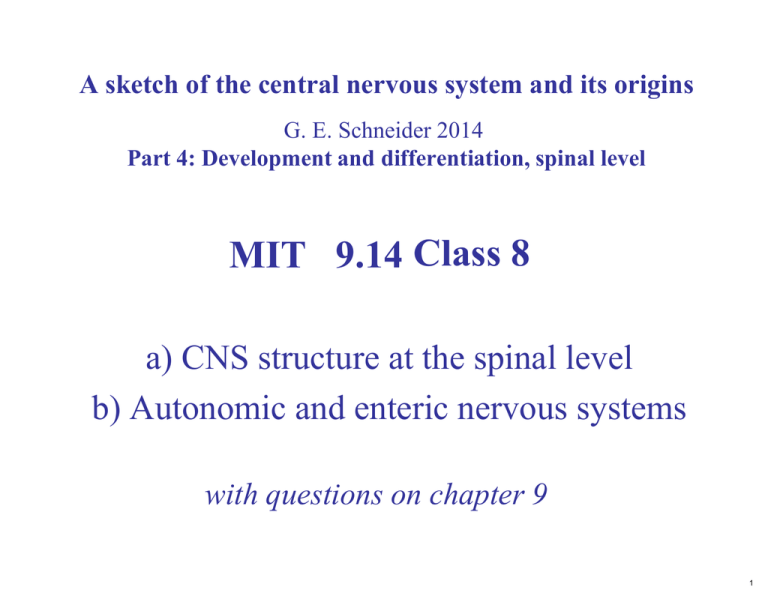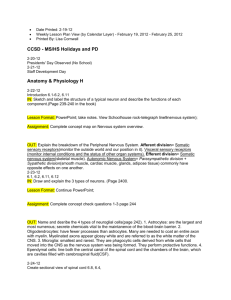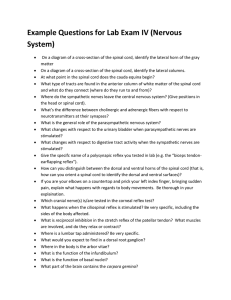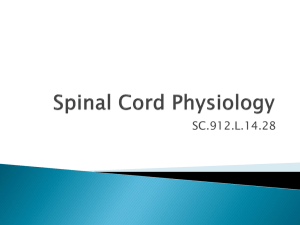Document 13493776
advertisement

A sketch of the central nervous system and its origins G. E. Schneider 2014 Part 4: Development and differentiation, spinal level MIT 9.14 Class 8 a) CNS structure at the spinal level b) Autonomic and enteric nervous systems with questions on chapter 9 1 Survey of adult human spinal cord • Different levels, illustrated • The sensory channels (reflex, spinocerebellar and spinothalamic tracts, origin of dorsal column axons) • Major descending pathways (cortico-, rubro-, reticulo-, and vestibulo-spinal) • “Propriospinal” fibers 2 Questions, chapter 9 1) How do the dorsal, lateral and ventral columns of the spinal cord change from cervical to sacral levels? Why? 4) What is the lateral horn? 3 Human spinal cord, frontal sections from first cervical segment to fourth sacral segment. Internal Structure Spinal Cord Segment C1 Segment C5 Segment C8 Segment T2 The white matter, consisting mostly of myelinated axons, is depicted in darker brown in these sections. Segment T10 Segment L1 Segment L4 Segment S4 Image by MIT OpenCourseWare. 4 Different levels, illustrated: Note the following things • Gray vs. white matter. • Gray matter differences in dorsal and ventral horns Changes in amount of white matter, rostral to caudal • More and more descending axons leave the white matter • More and more ascending axons join the white matter • Cervical and lumbar enlargements – How large in the spinal cord of Brontosaurus ? • Presence of “lateral horn” in thoracic and upper lumbar cord 5 Figure removed due to copyright restrictions. Spinal cords of turtle and Brontosaurus Note that the lumbar enlargement of Brontosaurus was larger than the brain. 6 Questions, chapter 9 2) What did Bror Rexed add to the way anatomists describe spinal cord sections stained for cell bodies? 7 Figures removed due to copyright restrictions. Please see course textbook or: Rexed, Bror. "A Cytoarchitectonic Atlas of the Spinal Coed in the Cat." Journal of Comparative Neurology 100, no. 2 (1954): 297-379. Cat spinal cord, Nissl stain of frontal section, 7th cervical segment, illustrating the layers specified by Rexed in his studies based on cytoarchitecture. 8 Questions, chapter 9 3) Describe some differences in cytoarchitecture of the dorsal horn and the ventral horn of the spinal cord. At what levels are these differences greatest? 9 More comparisons • Myelin – “A crucial vertebrate innovation” (Allman p. 78): Why myelin? – Not found in any invertebrate or in the jawless vertebrates (hagfish, lampreys) • How does spinal cord of humans differ from spinal cords of other mammals? Because of greatest sensory acuity in fingers, and greater manual dexterity, more ascending axons in dorsal columns and more descending axons from neocortex in lateral columns. 10 Spinal cord cross section Lumbar level, human Figure removed due to copyright restrictions. Please see course textbook or: Brodal, Per. The Central Nervous System, Structure and Function. 3rd ed. Oxford University Press, 2003. 11 Lumbar spinal cord, rat, unstained section; chart showing layers of Rexed Figure removed due to copyright restrictions. Please see: Gibson, Sally J., Julia M. Polak, et al. "The Distribution of Nine Peptides in Rat Spinal Cord with Special Emphasis on the Substantia Gelatinosa and on the Area around the Central Canal (laminaX)." Journal of Comparative Neurology 201, no. 1 (1981): 65-79. Fig 9-4 12 Survey of adult human spinal cord • Different levels, illustrated • The sensory channels (reflex, spinoreticular & spinothalamic, and spinocerebellar tracts; origin of dorsal column axons) • Major descending pathways (reticulo-, vestibulo-, rubro-, and corticospinal) • “Propriospinal” fibers 13 Questions, chapter 9 5) Where do the largest axons in the dorsal roots originate? Describe two of their terminate sites within the spinal segment of their dorsal root. 14 Termination of dorsal root fibers Largest axons in dorsal root come from stretch receptors in the striated muscles. They end on motor neurons that innervate the same muscles. This is the stretch reflex. Courtesy of MIT Press. Used with permission. Schneider, G. E. Brain structure and its Origins: In the Development and in Evolution of Behavior and the Mind. MIT Press, 2014. ISBN:9780262026734. 15 Questions, chapter 9 6) Describe the axons and connections of a withdrawal reflex (flexion reflex). 7) Describe the origins of the spinothalamic tract within a section of the spinal cord. Contrast this with the origins of the spinoreticular tract. 16 Adult spinal cord, schematic frontal section: reflex and lemniscal channels Dorsal columns Dorsal root fibers of various sizes Spinothalamic tract Courtesy of MIT Press. Used with permission. Schneider, G. E. Brain structure and its Origins: In the Development and in Evolution of Behavior and the Mind. MIT Press, 2014. ISBN:9780262026734. 17 Adult spinal cord, schematic frontal section: reflex and lemniscal channels Dorsal columns Spinothalamic tract Dorsal root fibers of various sizes Spinoreticular axons Courtesy of MIT Press. Used with permission. Schneider, G. E. Brain structure and its Origins: In the Development and in Evolution of Behavior and the Mind. MIT Press, 2014. ISBN:9780262026734. 18 REVIEW Remaining from very early chordates: Spinoreticular fibers Figure of the spinoreticular fibers that have been retained from very early chordates was removed due to copyright restrictions. Please see: Gray, Henry, and Susan Standring. Gray's Anatomy: The Anatomical Basis of Clinical Practice. Elsevier/Churchill Livingstone, 2008. (on right in blue) [from medical textbook] 19 Spinoreticular axons include a few that reach thalamus Figure of the spinoreticular fibers that have been retained from very early chordates was removed due to copyright restrictions. Please see: Gray, Henry, and Susan Standring. Gray's Anatomy: The Anatomical Basis of Clinical Practice. Elsevier/Churchill Livingstone, 2008. 20 Questions, chapter 9 8) Where do the longest axons of the dorsal columns originate and where do they terminate? 21 At the rostral end of the spinal cord: Termination of dorsal column axons The dorsal column nuclei, namely, the gracile and cuneate nuclei (nuc. gracilis and nuc. cuneatus): Some textbooks define their location as in caudal hindbrain. Where do the longest axons originate? Where to they terminate in the DCN? 22 Questions, chapter 9 9) Explain how there is an organized representation of the surface of the entire body in cell groups at the dorsal-most end of the spinal cord. 23 The body surface represented at the hindbrain-spinal cord boundary 24 Questions, chapter 9 10) Describe the sources of axons terminating in Clarke’s column (nucleus dorsalis) of the spinal cord from the lower limbs. What ascending fiber tract originates in Clarke’s column? 25 Cerebellar channel: Clarke’s Column and the dorsal spino-cerebellar tract illustrated at 5th thoracic segment (see Nauta & Feirtag, Fig. 64) Carries information on joint movements from lower limbs & trunk 26 Image by MIT OpenCourseWare. Clarke’s Column and dorsal spino-cerebellar tract 27 Questions, chapter 9 11) What are propriospinal fibers? 12) Movements of the limbs and other movements are controlled or influenced by a number of axonal groups that descend from the brain. What can you remember about these? (such as names and where they originate, and how many such pathways there are) 28 Adult spinal cord: some descending and intrinsic axons Propriospinal axons Corticospinal axons (after their decussation) Rubrospinal axons Reticulospinal, Vestibulospinal, Fastigiospinal (from Cb), Tectospinal Corticospinal axons, uncrossed (variable in quantity) Courtesy of MIT Press. Used with permission. Schneider, G. E. Brain structure and its Origins: In the Development and in Evolution of Behavior and the Mind. MIT Press, 2014. ISBN:9780262026734. 29 Ascending and descending long axons of primate spinal cord Ascending axons Ascending and descending axons Corticospinal axons (after their decussation) Rubrospinal axons Reticulospinal, Vestibulospinal, Fastigiospinal (from Cb), Tectospinal Corticospinal axons, uncrossed (variable in quantity) Courtesy of MIT Press. Used with permission. Schneider, G. E. Brain structure and its Origins: In the Development and in Evolution of Behavior and the Mind. MIT Press, 2014. ISBN:9780262026734. 30 Next: Shift from the spinal cord to components of the PNS 31 Questions, chapter 9 13) The peripheral nervous system innervates glands and smooth muscles, also cardiac muscle, as well as skin and striated muscles. What is the system called that innervates the visceral tissues? What are the two divisions of that visceral nervous system? 32 Autonomic nervous system (ANS): Dual innervation of smooth muscles and glands • Sympathetic nervous system (thoracolumbar system) • Parasympathetic nervous system (cranio-sacral system) 33 Questions, chapter 9 14) Contrast the functions of the two systems. Briefly describe some examples. 34 Important functions of some autonomic pathways GLAND, TISSUE SYMPATHETIC FUNCTIONS PARASYMP. FUNCTIONS Iris Dilates pupil (mydriasis) Constricts pupil (miosis) Lacrimal gland Little effect on secretion Stimulates secretion Salivary glands Secretion reduced; less watery Secretion increased; watery Sweat glands Stimulates secretion (ACh) Little effect Lungs, bronchi Dilates the lumen Constricts Heart Speeds heart rate; increased ventricular contraction Slows heart rate Stomach, intestines Inhibits motility & secretions Stimulates motility, secretions Anal sphincters Constricts except with very intense activation Relaxes Sex organs Orgastic contraction of ductus deferens, seminal vesicle, prostatic or uterine muscles; vasoconstriction Vasodilation, engorgement of erectile tissue Urinary bladder Relaxes wall of bladder; constricts internal sphincter, inhibits emptying Contracts bladder, relaxes sphincter, promotes emptying 35 Important functions of some autonomic pathways GLAND, TISSUE Adrenal medulla SYMPATHETIC FUNCTIONS Stimulates secretion Constrict Blood vessels, trunk & extremities Blood vessels, head Dilate PARASYMP. FUNCTIONS Little or no effect --- --- 36 Questions, chapter 9 15) Striated muscles have synaptic innervation, whereas smooth muscles and glands have paracrine innervation. Explain the difference. Where are the neurons located that give rise to the axons that innervate the glands and smooth muscle? 37 Step back a moment: Arrangement of motor neurons in the three major divisions of the motor system S E S Somatic: Synaptic P Autonomic: Paracrine Neuroendocrine: Endocrine Image by MIT OpenCourseWare. 38 Arrangements within the Autonomic Nervous System: Paracrine innervation (P. Brodal & others) EFFECTOR CNS GANGLION SYMPATHETIC PREGANGLIONIC PARASYMPATHETIC POSTGANGLIONIC GANGLION Image by MIT OpenCourseWare. 39 Autonomic pathways: a selective schematic view Thoraco -lumbar Courtesy of MIT Press. Used with permission. Schneider, G. E. Brain Structure and its Origins: In the Development and in Evolution of Behavior and the Mind. MIT Press, 2014. ISBN:9780262026734. 40 MIT OpenCourseWare http://ocw.mit.edu 9.14 Brain Structure and Its Origins Spring 2014 For information about citing these materials or our Terms of Use, visit: http://ocw.mit.edu/terms.






